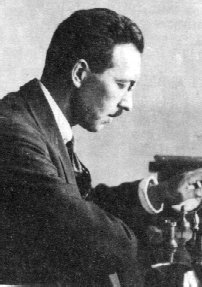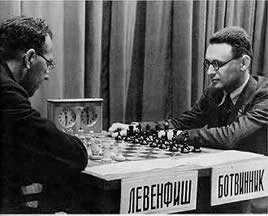Grigory Levenfish facts for kids
Quick facts for kids Grigory Levenfish |
|
|---|---|
 |
|
| Full name | Grigory Yakovlevich Levenfish |
| Country | Russian Empire → Soviet Union |
| Born | 19 March 1889 Piotrków, Congress Poland, Russian Empire |
| Died | 9 February 1961 (aged 71) Moscow, Soviet Union |
| Title | Grandmaster (1950) |
Grigory Yakovlevich Levenfish (Russian: Григо́рий Я́ковлевич Левенфи́ш; March 19, 1889 – February 9, 1961) was a very strong chess player from the Soviet Union. He was best at chess in the 1920s and 1930s. He won the Soviet chess championship two times. He won in 1934 (sharing the title with Ilya Rabinovich) and again in 1937. In 1937, he played a match against Mikhail Botvinnik, who later became a world champion, and they tied. In 1950, Levenfish was one of the first players to be given the title of Grandmaster by FIDE. This was the first time this important title was given out.
Contents
Early Life and Education
Grigory Levenfish was born in a city called Piotrków, which is in Poland. At that time, Poland was part of the Russian Empire. His parents were Jacob and Golda Levenfish. He grew up mostly in St. Petersburg. There, he went to the Saint Petersburg State Institute of Technology. He studied to become a chemical engineer.
First Chess Wins
Levenfish first became known as a great chess player when he won the St. Petersburg championship in 1909. He was only 20 years old. In 1911, he played in a big tournament called the Carlsbad tournament. He scored 11½ points out of 25 games. This was his first and only tournament outside of Russia or the Soviet Union. People even compared his playing style to Mikhail Chigorin, a famous Russian chess master. In the next ten years, he won the Leningrad Championship three times: in 1922, 1924, and 1925 (sharing the win).
Becoming a Soviet Champion
Levenfish did very well in the Soviet Championship. He finished in the top three four times. He was third in 1920 and second in 1923. In 1934, he became co-champion in Leningrad, tying with Ilya Rabinovich. He won the championship all by himself in 1937 in Tbilisi. He scored 12½ points out of 19 games.
In 1935, he played in the Moscow International tournament. He tied for 6th–7th place. Mikhail Botvinnik and Salo Flohr won that tournament. In 1936, he was third in a Soviet-only tournament in Leningrad. He also tied for 3rd–6th place in a training tournament in 1939.
Levenfish also played well in one-on-one matches. He tied a 13-game match with Botvinnik in 1937. In 1940, he beat Vladimir Alatortsev.
Challenges and Recognition
Even with all his success, the Soviet chess leaders did not support Levenfish much. They focused more on younger players like Botvinnik, who was a strong communist. Levenfish was one of the only top Soviet players who did not get money from the government. This meant he lived in a small, cold room.
The government also stopped him from traveling outside the Soviet Union. He could not play in big tournaments like AVRO 1938, even though he was the Soviet Champion. This made things harder for him and might have affected his chess playing. Other famous players born before the revolution, like Alexander Alekhine and Efim Bogoljubow, were allowed to travel and even live abroad.
Because he could not travel, Levenfish only played chess in the Soviet Union. He also worked as an engineer in the glass industry to earn money. This slowly led him to play less chess.
In 1950, FIDE, the world chess organization, gave Levenfish the title of International Grandmaster. This was the first year this important title was given out.
His Legacy in Chess
Genna Sosonko, a chess writer, said that Levenfish was an honest and independent person. He never complained about his hard life. Boris Spassky, another grandmaster, saw Levenfish shortly before he died. Levenfish looked very tired and had just had six teeth removed.
Vasily Smyslov, a world champion, shared a story about Levenfish. Towards the end of his life, Levenfish visited Smyslov with many papers. It was a book he had written about rook endgames (the final part of a chess game). He asked Smyslov to check it for mistakes. After a few small changes, the book was published in 1957. It was called Teoriya ladeynykh okonchaniy (The theory of rook endings). Smyslov said that Levenfish did all the hard work for the book.
| This example uses algebraic notation. |
Levenfish also wrote chess books for beginners. He helped edit a book about chess openings called Sovremenny debyut (Modern openings). After he died, his autobiography was published in 1967. It was called Izbrannye partii i vospominaniya and included 79 of his chess games with notes.
People who knew Levenfish said he understood chess very deeply. He was also good at finding brilliant and creative moves. He also studied chess openings. A special move in the Sicilian Defence chess opening is named after him. It is called the Levenfish Attack.
How He Played Chess
Levenfish beat almost all the best Russian and Soviet players from the 1910s to the early 1950s. He even beat world champions Alexander Alekhine and Emanuel Lasker. However, he sometimes lost to younger stars like Paul Keres and David Bronstein.
When playing as Black, Levenfish was very strong with the French Defence and the Slav Defence openings. He usually liked classic openings such as the Ruy Lopez and the Queen's Gambit. But sometimes, he would try more modern openings like the Grünfeld Defence and the Nimzo-Indian Defence.
Books He Wrote
- Izbrannye partii i vospominaniya, by Grigory Levenfish, 1967. This book is in Russian. It was translated into English in 2019 and called Soviet Outcast.
- Rook Endings, by Grigory Levenfish and Vasily Smyslov. This book was translated into English in 1971.
- Sovremenny debyut, edited by Grigory Levenfish, 1940. This book is in Russian.
See also
 In Spanish: Grigori Levenfish para niños
In Spanish: Grigori Levenfish para niños


